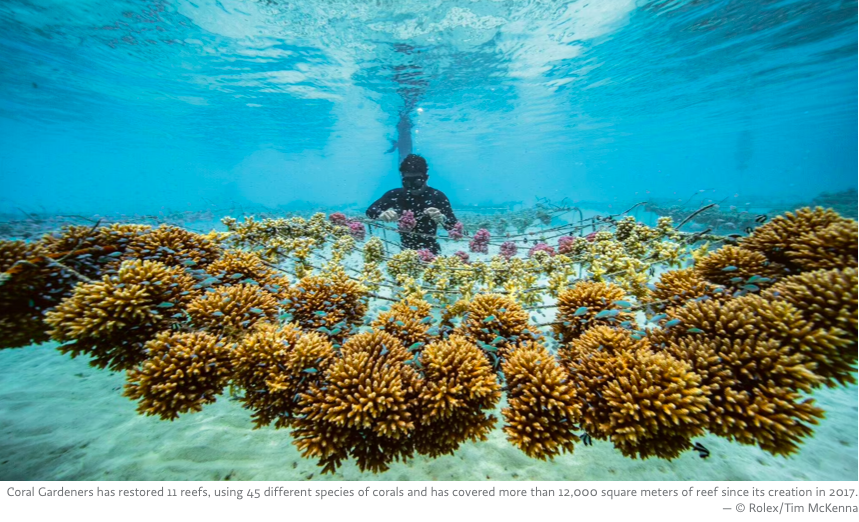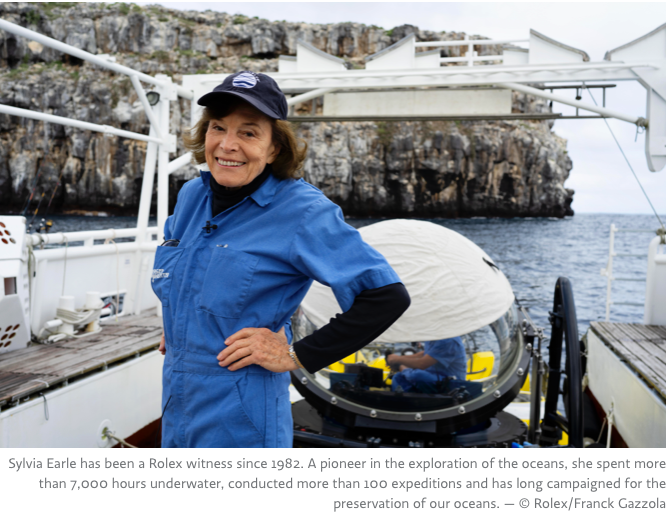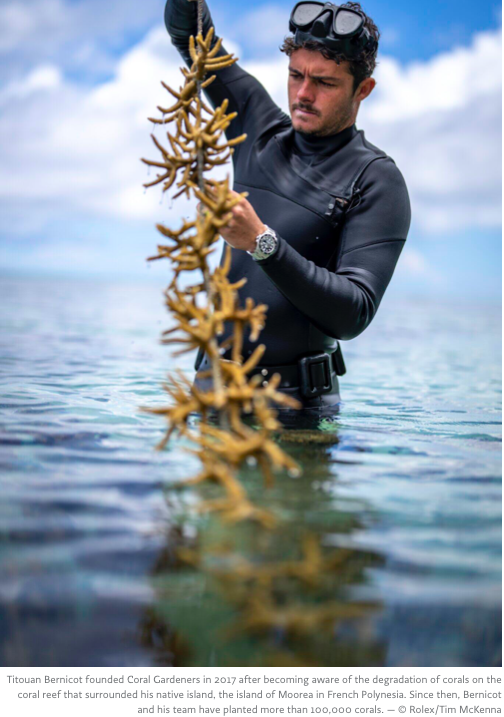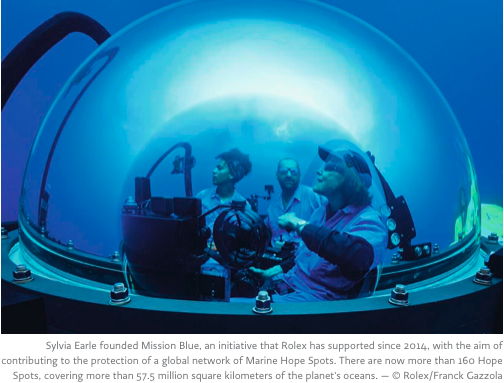Oceanographer Sylvia Earle has been surveying the seabed for more than sixty years. Titouan Bernicot founded Coral Gardeners, an organization for the protection of coral reefs. They warn about the importance of protecting marine ecosystems

On the occasion of World Ocean Day, June 8, Rolex, through its Perpetual Planet Initiative, organized a discussion between Titouan Bernicot, founder of Coral Gardeners and Sylvia Earle, renowned oceanographer. The opportunity for the company to show its commitment to these essential blue expanses that cover more than 70% of the planet. The ocean alone absorbs nearly half of the CO2 emitted into the atmosphere by human activities and captures 90% of the heat generated by them. The ocean is home to the majority of terrestrial biodiversity. But only a quarter of the ocean depths have been mapped and only 5% explored. This abyssal vacuum does not prevent the ongoing mass extinction in the seabed. Scientists estimate that between 1970 and 2018, at least 70% of ocean sharks disappeared. Coral reefs, so essential to the survival of hundreds of thousands of people and the protection of the coasts, are in danger. « The ocean is dying, » warns the famous oceanographer, explorer and professor Sylvia Earle and « Rolex testimony » since 1982. This pioneer of the oceans has been surveying the underwater depths for more than sixty years. « At the beginning of my career, no one thought that the ocean could be in danger, » she reports. But thousands of hours spent in the seabed showed him the opposite: « I saw the price paid by nature ».

I saw the price paid by nature
Sylvia Earle, oceanographer and explorer
In contact with water, CO2 dissolves naturally, which causes the water to acidify. This directly impacts many marine organisms, such as zooplankton. Its shell, composed of calcium carbonate, is much more complicated to manufacture in an acidic environment. And since the food chain of ocean waters passes through zooplankton before reaching the rest of the marine fauna, it is potentially the entire beginning of the food chain that is in danger.
Global warming also induces a decrease in the salinity of the oceans (via the melting of glaciers) which causes the slowdown of currents, and involves an irremediable increase in the temperature of the waters of the warm regions of the planet. This rise in temperatures has a dramatic impact on corals, half of which have already died.
A network of explorers and scientists
This disappearance, Titouan Bernicot, « the child of the ocean », observed it with his own eyes. He grew up in French Polynesia, in a small atoll where his parents cultivated Tahitian pearls. A childhood punctuated by the waves where everything relates to the ocean. « The coral reef is my whole life. These are the best waves. It’s the fish we eat. This is our protection against storms, « he smiles. « A coral reef is not just a reef. It is an ecosystem that includes thousands of species. To have healthy coral reefs you need healthy oceans, » insists Sylvia Earle. In 2015, at the age of 16, Titouan Bernicot realized that corals were whitening. « I didn’t have time to study this phenomenon at school, I had to act, and quickly, » he reports. An optics that Sylvia Earle also defends: « Before, we had the luxury of studying. Now we must act. » At the age of 18, Titouan founded Coral Gardeners, with whom he reinvented the rules of conservation by showing young people that by restoring coral reefs, it is the entire environment that he protects. « Rolex and its Perpetual Planet Initiative [of which Coral Gardeners became a partner in 2022] and National Geographic were my school. Thanks to them, I have access to a network of explorers, scientists. I can tell them about what I see underwater in our garden and they give me explanations. It’s fantastic! » he exclaims.

As close as possible to corals
Coral « cultivators » collect coral fragments from colonies that have withstood the bleaching episodes they grow in nurseries for twelve to eighteen months, then « stick » them to other reefs nearby with marine cement, and then follow their growth. Titouan Bernicot already notices the concrete impact of their action on corals: colors and life are back. Currently, Coral Gardeners grows about 30,000 corals underwater in eight different nurseries scattered throughout French Polynesia and three in Fiji. The association achieved its goal of planting 100,000 corals at the end of 2023.
100,000 corals planted thanks to Coral Gardeners
However, the beginnings were difficult. The corals of the nurseries were bleaching. « I was very scared. I thought we were all going to lose them. Then, I realized that 20 cm from the coral that was bleaching and dying, another was resisting. It’s like humans in the face of viruses. Some people react differently than others. It does not depend on the species but on the individuals within a species. Nature needs to be diversified to function well, « he reports. Today, four scientists are working full-time with Coral Gardeners to develop the best possible conservation strategy. The association focuses on « resilient » corals. That is, those who, over 50 years of age, survived the first wave of coral bleaching, which dates from 1998.

Technology at the service of the environment
Followed by nearly 670,000 followers on Instagram, Coral Gardeners defends the use of technology to communicate and awaken consciences. « In the past, technology has been used a lot to destroy the planet. But she can help save her. It would be a shame not to use it to collect data. Before, we needed a month to monitor a coral reef. Now it takes us three days. »

This technology and the information collected on the seabed give Sylvia Earle hope: « This is the best time to be alive. Like Titouan and his colleagues, they know what to do and do it! » For her, the main problem of the oceans is that « no one is aware of their importance ». That’s why Sylvia Earle created, in 2009, an ambitious ocean conservation project, Mission Blue. The program aims to create a global network of marine protected areas: the Hope Spots. Since 2014, Rolex has supported Mission Blue in its efforts to help protect 30% of the world’s seas by 2030, in accordance with the objective recommended by the International Union for Conservation of Nature (IUCN) to preserve the health of the oceans. More than 163 Hope Spots (hope points) have already been recognized. « Today, only 3% are protected. This means that 97% of its surface is open to mines, industrial fishing… » warns the pioneer of the oceans who jumps from one conference to another, in the hope of alerting to the importance of the conservation of these ecosystems. « We must absolutely expand the safeguarding of the oceans. Protect them as if our life depended on it because it is the case, « concludes Sylvia Earle.
For Titouan Bernicot, the conservation of the oceans, in addition to being essential, must become a new model of society: « Every citizen must be able to participate with his or her hands. May the protection of the planet be enriching, « cool », meaningful and fun ».
Source: Le Temps



